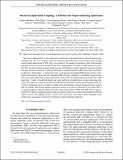| dc.contributor.author | Cascales Sandoval, Juan Pedro | |
| dc.date.accessioned | 2020-05-21T15:42:52Z | |
| dc.date.available | 2020-05-21T15:42:52Z | |
| dc.date.issued | 2020-01-17 | |
| dc.identifier.issn | 2331-7019 | |
| dc.identifier.uri | https://hdl.handle.net/1721.1/125379 | |
| dc.description.abstract | Spin-orbit coupling (SOC) is a key interaction in spintronics, allowing electrical control of spin or magnetization and, vice versa, magnetic control of electrical current. However, recent advances have revealed much broader implications of SOC that is also central to the design of topological states with potential applications from low-energy dissipation and faster magnetization switching to high tolerance of disorder. SOC and the resulting emergent interfacial spin-orbit fields are simply realized in junctions through structural inversion asymmetry, while the anisotropy in magnetoresistance (MR) allows their experimental detection. Surprisingly, we demonstrate that an all-epitaxial ferromagnet/MgO/metal junction with a single ferromagnetic region and only negligible MR anisotropy undergoes a remarkable transformation below the superconducting transition temperature of the metal. The superconducting junction has a MR anisotropy 3 orders of magnitude higher and could enable novel applications in superconducting spintronics. In contrast to common realizations of MR effects that require a finite applied magnetic field, our system is designed to have two stable zero-field states with mutually orthogonal magnetizations: in plane and out of plane. This bistable magnetic anisotropy allows us to rule out orbital and vortex effects due to an applied magnetic field and identify the SOC origin of the observed MR. Such MR reaches approximately 20% without an applied magnetic field and could be further increased for large magnetic fields that support vortices. Our findings call for a revisit of the role of SOC, even when it seems negligible in the normal state, and suggest an alternative platform for superconducting spintronics. | en_US |
| dc.publisher | American Physical Society | en_US |
| dc.relation.isversionof | http://dx.doi.org/10.1103/PhysRevApplied.13.014030 | en_US |
| dc.rights | Article is made available in accordance with the publisher's policy and may be subject to US copyright law. Please refer to the publisher's site for terms of use. | en_US |
| dc.source | American Physical Society | en_US |
| dc.title | Interfacial Spin-Orbit Coupling: A Platform for Superconducting Spintronics | en_US |
| dc.type | Article | en_US |
| dc.identifier.citation | Martínez, Isidoro et al. “Interfacial Spin-Orbit Coupling: A Platform for Superconducting Spintronics.” Physical review applied 13 (2020): 014030 © 2020 The Author(s) | en_US |
| dc.contributor.department | Massachusetts Institute of Technology. Plasma Science and Fusion Center | en_US |
| dc.contributor.department | Francis Bitter Magnet Laboratory (Massachusetts Institute of Technology) | en_US |
| dc.relation.journal | Physical review applied | en_US |
| dc.identifier.mitlicense | PUBLISHER_POLICY | |
| dc.identifier.mitlicense | PUBLISHER_POLICY | |
| dc.eprint.version | Final published version | en_US |
| dc.type.uri | http://purl.org/eprint/type/JournalArticle | en_US |
| eprint.status | http://purl.org/eprint/status/PeerReviewed | en_US |
| dc.date.updated | 2020-01-17T15:52:46Z | |
| dc.language.rfc3066 | en | |
| dc.rights.holder | American Physical Society | |
| dspace.date.submission | 2020-01-17T15:52:45Z | |
| mit.journal.volume | 13 | en_US |
| mit.journal.issue | 1 | en_US |
| mit.metadata.status | Complete | |
